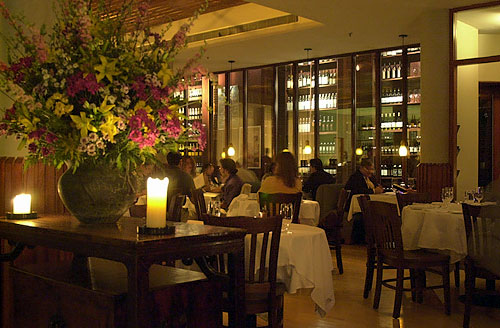Piora
 Tuesday, March 4, 2014 at 12:02PM
Tuesday, March 4, 2014 at 12:02PM  You figured Chris Cipollone was gonna get another shot. The food media loved Tenpenny, his restaurant in the back of a midtown hotel, but he followed the founding GM (Jeffrey Tascarella) quickly out the door, citing low pay.
You figured Chris Cipollone was gonna get another shot. The food media loved Tenpenny, his restaurant in the back of a midtown hotel, but he followed the founding GM (Jeffrey Tascarella) quickly out the door, citing low pay.
After a brief stint at Abe & Arthur’s in the Meatpacking District, he resurfaced at Piora, in the lovely West Village space that was The Goodwin. Going by the critical acclaim (three sparklers from Sutton, two apiece from Wells and Platt) and the difficulty of getting a reservation, I’d say Cipollone’s gonna be here a while.
Critics have struggled to describe the cuisine: Sutton called it “French–Italian–Korean fusion.” Wells said merely that “Korean flavors dart in and out of the menu.” (Owner Simon Kim is part Korean.) But in a lengthy interview with the Village Voice, Cipolline said, “we’re a modern American restaurant” and “we’re not fusing much.”
To the average diner, walking in the door without reading the publicity, Piora seems more Italian than anything else, down to even its vowel-heavy name, which in fact is the Korean word for “blossom.” But you’ll see a section of the menu for pastas, and assume the place must be Italian, although the menu is not in the standard five-part format, and there are no Italian headings like primi or contorni.
Actually, there are no headings at all, and the pastas are entrée-sized. As you’d expect for a hit restaurant, prices have edged up over the last six months. Chicken at opening ($26) is now Poussin ($29). The acclaimed Bucatini pasta has gone from $26 to $36; the duck from $28 to $33. But the chef now serves an amuse bouche, of which I saw no mention in the early reviews. An $85 tasting menu has been added, and there’s the obligatory off-menu dry-aged 40-ounce ribeye for two ($150).
None of this is to suggest that Piora is charging too much. This is simply the arc that successful restaurants travel. For the quality of the food, Piora is fairly priced, with appetizers $15–20, entrées (including pastas) $25–36, and side dishes $9. The menu is blissfully short, with fewer than twenty items fitting on one generously-spaced page.


















